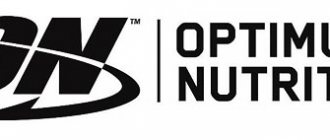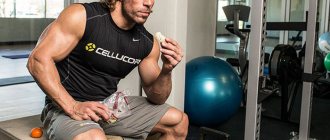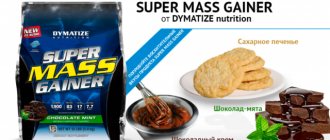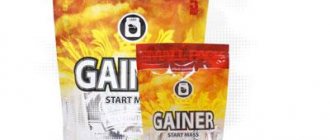It must be remembered that insulin in sports is not entirely suitable for novice athletes, because it is a very powerful and serious drug. If used incorrectly, it can cause harm to the body and even lead to death.
The main advantage of insulin is that it is a transport hormone, meaning it delivers nutrients to cells. We are primarily talking about glucose (carbohydrates), but also amino acids (proteins) and triglycerides (fats) depend on the work of this substance. To understand the essence of the activity of insulin, you need to decide what the three above-mentioned groups of compounds are needed for.
The transfer of carbohydrates by insulin leads to an increase in energy processes, the transport of proteins leads to muscle growth, and the transport of fats leads to fat growth. Based on this, it becomes clear that insulin is an assistant for both muscle gain and fat gain. Which effect will predominate depends on two factors:
- diet – the more protein the diet contains and the less carbohydrates, the better;
- genetics - it determines body type. The more fat a person has, the more harmful insulin will be for him.
Insulin in bodybuilding is capable of transporting everything, but the emphasis can be placed differently: either the path of anabolism, that is, muscle growth, or an increase in fat mass will predominate. Moreover, it is impossible to achieve one goal by completely abandoning another path. In any case, both fat gain and muscle mass growth will occur.
If a person is by nature an ectomorph (has thin bones and little fat), then insulin will help him more than harm him, because his insulin resistance is reduced. If a person is an endomorph (has a belly, gains fat easily, has thick bones), then he has high insulin resistance, which means there is no point in using it.
Insulin in sports[edit | edit code]
Read the main article:
insulin
In 1889, in animal experiments it was found that removal of the pancreas causes diabetes mellitus. In 1901, V.L. Sobolev experimentally confirmed the presence of a special substance in the pancreas and formulated the principles for producing insulin. In 1921, F. G. Banting and C. H. Best obtained an extract from the pancreas that eliminated the symptoms of diabetes mellitus. In 1925, a crystalline protein with the properties of an insulin hormone was isolated from the pancreas, and in the same year its industrial production for medical needs began. During 1945-1947. The chemical structure and molecular weight of insulin were established. In 1963, the synthesis of this hormone was carried out. The specific activity of 0.04082 mg of crystalline insulin (standard) is taken as one action unit (AU). Currently, about 4% of the population of industrialized countries are forced to inject themselves with insulin for health reasons.
Physiology[edit | edit code]
Insulin is a protein hormone consisting of two polypeptide chains A and B, containing 21 and 30 amino acids, respectively, connected by two disulfide bonds. The molecular weight of insulin monomer is 5733.5. Insulin is synthesized by β-cells of the islet apparatus of Langerhans of the pancreas and, possibly, by the parotid salivary glands. Stepwise proteolysis leads to the formation of proinsulin. After the formation of disulfide bridges, the connecting peptide is cleaved, after which biologically active insulin is formed.
The pancreas of a healthy person contains the equivalent of 200 units of insulin. Regulation of insulin secretion is a complex process that includes stimulants (glucose, amino acids, free fatty acids, enterohormones, etc.), the effect of which is enhanced by calcium ions, and inhibitors (somatostatin, prostaglandins, adrenaline and insulin itself). In addition, the autonomic nervous system has an influence: the sympathetic is inhibitory, the parasympathetic is stimulating. Normal insulin secretion includes two components: basal, which prevents hypercatabolism on an empty stomach, and stimulated by food intake. Insulin released from the pancreas circulates in the blood in free and protein-bound forms.
The free hormone stimulates the uptake of glucose by both muscle and adipose tissue, while the bound hormone acts specifically only on adipose tissue. Insulin inactivation occurs in the liver and other insulin-sensitive organs and tissues.
Mechanisms of action of insulin
Positive aspects of hypoglycemia and is it dangerous?
It should be remembered that hypoglycemia can be of various types.
With a mild form, a person’s appetite increases, which can be used for one’s benefit. A more severe form of hypoglycemia can no longer bring anything good, but hypoglycemic coma is quite possible. Thus, it can be argued that athletes should use short-acting drugs to induce mild hypoglycemia. Of course, for this it is necessary to choose the right dosage. There are also quite often questions about the advisability of using drugs that stimulate insulin synthesis, for example, Maninil. Their use by athletes seems inappropriate. Thanks to the injection, it is possible to provide the required level of the hormone for a period of time sufficient to obtain the effect. When using drugs like Maninil, it is impossible to know how the body will react to it and how much hormones will be produced.
Another thing is drugs that increase insulin sensitivity, for example, Metformin or Siofor. If desired, you can conduct experiments with them and determine the need for their further use. Every athlete must understand that if he wants to develop only within the limits of his own genetics, then he does not need to use any drugs. If he intends to develop further, then in this case he cannot do without pharmacology. But you should also be prepared for the consequences of its use. The question here is when they will manifest themselves.
Effects of insulin[edit | edit code]
Insulin plays an important and multifaceted role as a biocatalyst of metabolic processes. It promotes the passage of glucose from the blood into tissues and its conversion into glycogen in the liver and skeletal muscles. Insulin increases the permeability of biological membranes to glucose, amino acids, ions and oxygen and stimulates their consumption by tissues. Under the influence of insulin, the processes of oxidative phosphorylation are enhanced due to the activation of the tricarboxylic acid cycle and the hexokinase reaction, which is the first and key stage of glucose metabolism. In tissues, glucose is found mainly in the interstitial fluid, and glucohexokinase is found inside the cells. By increasing the permeability of cell membranes, insulin promotes the penetration of glucose into the cytoplasm of cells, where it is exposed to the enzyme. It inhibits the activity of glucose-6-phosphatase, which catalyzes glycogenolysis.
Insulin enhances anabolic effects in cells: increases the synthesis of proteins, lipids and nucleic acids, activates the oxidation of fatty acids and affects the growth of the body. As an anti-catabolic factor, it inhibits glyconeogenesis and prevents the dehydrogenation of free fatty acids and the formation of glucose precursors.
When there is a deficiency of insulin or a decrease in the sensitivity of tissues to the endogenous hormone, the body loses the ability to consume glucose and diabetes develops. The leading symptoms of diabetes mellitus are thirst and polyuria (6-10 l per day), hyperglycemia (6.7 mmol-l"1 and above, determined on an empty stomach) and glucosuria (10-12%), decreased glycogen content in the liver and muscles, disturbance of protein metabolism, incomplete oxidation of fats with an increase in their content in the blood (lipidemia) and metabolic acidosis (ketonemia). With severe diabetes mellitus, diabetic coma is possible. With a low level of active insulin in the blood, the concentration of glucose, free fatty acids and amino acids increases, i.e. substances that play a role in the pathogenesis of diabetic angiopathy and arteriosclerosis.
Diabetes mellitus[edit | edit code]
Based on the pathogenesis and clinical picture, diabetes mellitus is divided into two types: type I - insulin dependent and type II - non-insulin dependent.
The first type includes patients with primary damage to the beta cells of the pancreas, leading to a decrease in insulin synthesis. This form occurs mainly in children and young people.
The basis of type 2 diabetes mellitus is a decrease in the sensitivity of tissue receptors to endogenous insulin due to metabolic disorders, as well as disturbances in the neurohumoral regulation of the secretion of the islet apparatus of the pancreas. Type II occurs in elderly and middle-aged people and is often accompanied by obesity.
Effects of Insulin on Exercise
The effect of the hormone on jock athletes:
Anabolic effect.
Anabolic effect. Speeds up:- amino acid absorption;
- protein biosynthesis;
- delivery of magnesium, potassium and phosphate to cells;
- RNA replication.
synthesis of carboxylic acids;
- the process of breaking down fats, reducing the amount of carboxylic acids in the blood;
- synthesis of glycogen polysaccharide, forms glucose reserves;
Insulin preparations[edit | edit code]
Insulin preparations are used for pharmacotherapy of type I diabetes mellitus. For type II diabetes mellitus, synthetic glucose-lowering drugs are used, in some cases their effect is supplemented by the administration of insulin. Insulin, obtained from the pancreas of cattle, pigs and whales, provides a relatively short-term therapeutic effect. By adding the stabilizing low-molecular-weight protein protamine to insulin, as well as zinc (0.08 mg per 1 ml of the drug), a phosphate or acetate buffer, or a polymer base (low-molecular-weight polyvinylpyrrolidone), long-acting drugs (depot drugs) are obtained.
Insulin for injection has the shortest effect (6 hours), a suspension of zinc insulin (amorphous) has an average duration, and insulindez, created on a polymer basis, has the longest effect (30-36 hours).
The main indication for the use of insulin drugs in the clinic is diabetes mellitus. Insulin doses are set individually, depending on the severity of the disease, the patient’s condition and the sugar content in the urine (1 IU of the hormone per 2-5 g of sugar excreted in the urine).
Short-acting insulins
used to treat diabetic coma. Depot insulin preparations are prescribed in such a way that the maximum hypoglycemic effect coincides in time with the period of greatest glucosuria and hyperglycemia. These drugs are administered in the morning, on an empty stomach. Small doses of insulin (5-8 units) as an anabolic hormone are used for cachexia, furunculosis, toxicosis of pregnancy, peptic ulcers, hepatitis and other diseases in combination with increased protein-carbohydrate nutrition and glucose administration. In psychiatric practice, insulin is used to develop hypoglycemic shock in some forms of schizophrenia.
Instructions for using insulin
Indications for use
According to the instructions included in each package of the insulin drug, the indications for its use are type 1 diabetes mellitus (also called insulin-dependent) and in some cases type 2 diabetes mellitus (non-insulin-dependent). Such factors include intolerance to oral hypoglycemic agents and the development of ketosis.
Insulin administration
”alt=””>
The doctor prescribes the medication after diagnosis and blood tests. To treat diabetes mellitus, drugs of different durations of action are used: short and long. The choice depends on the severity of the disease, the patient’s condition, and the speed of onset of action of the drug:
- The short-acting drug is intended for subcutaneous, intravenous or intramuscular administration. It has a quick, short-term sugar-lowering effect; it is administered 15-20 minutes before meals several times a day. The effect occurs after half an hour, maximum - after two hours, in total it lasts about six hours.
- Long-term or prolonged action - has an effect lasting 10-36 hours, allowing you to reduce the daily number of injections. Suspensions are administered intramuscularly or subcutaneously, but not intravenously.
Insulin is administered subcutaneously using several methods.
The most common one is an insulin syringe. This product, made of transparent plastic, has four components: a cylinder-shaped body with markings, a rod moving inside it, a needle and a cap that covers it. The needle may be fixed in some models, but a removable version is more common.
Among the advantages of a syringe pen is the ability to inject insulin anywhere without taking off your clothes. Due to the presence of a very thin needle, pain during injection is practically not felt and the skin is not injured.
A sleeve filled with insulin is inserted into the cavity of the syringe. The accuracy of the administered dose is regulated by a special mechanism, which, when the release button is pressed, makes a click indicating the administration of one unit of the drug.
The syringe pen is placed in a case and has detailed instructions for use.
Insulin is prescribed for the following indications:
- type 1 diabetes;
- ketoacidosis;
- diabetic coma – hyperlaccidemic, hyperosmolar;
- decompensation of type 2 diabetes;
- diabetic nephropathy;
- weight loss in the presence of diabetes.
The selection of the type of insulin depending on the duration of exposure and the dose administered depends on many factors and is carried out individually. The main criterion is to achieve maximum compensation of carbohydrate metabolism.
”alt=””>
It is also important to achieve regularity in the action of the hormone, since significant daily fluctuations in glucose concentration parameters can provoke serious complications. This effect is expressed in enhancing the ability of cells to absorb a variety of vital substances, including glucose
Also, a more intense synthesis of glycogen begins with an increase in its volume and glycogenesis decreases, due to which the level of glucose in the blood is regulated, allowing it to maintain normal levels
This effect is expressed in enhancing the ability of cells to absorb a variety of vital substances, including glucose. A more intense synthesis of glycogen also begins with an increase in its volume and glycogenesis decreases, due to which the level of glucose in the blood is regulated, allowing it to maintain normal levels.
As a result of the anabolic effect of insulin, protein biosynthesis, the absorption of amino acids by cells, and the entry of magnesium and potassium into them are enhanced. In addition, glucose is broken down and converted into triglycerides.
Anti-catabolic effect
Insulin in sports[edit | edit code]
The use of insulin in sports as a doping is due to the fact that this hormone is characterized by a powerful anabolic and anti-catabolic effect on protein, carbohydrate and fat metabolism. When a sufficiently high dose of insulin is introduced into the body from the outside, a pronounced decrease in blood glucose occurs and a protective reaction is activated - an increase in the release of growth hormone, which helps to raise blood sugar levels. In some cases, the level of growth hormone can increase 5-7 times. This leads to a sharp increase in anabolism. In addition to the fact that insulin itself, after injection, provokes the release of growth hormone, it has been irrefutably proven that it also greatly enhances its effect, just like anabolic steroids. It becomes clear why the combination of growth hormone + insulin + anabolic steroids has become so popular in sports in recent years.
In addition to insulin levels, tissue sensitivity to this substance is very important. It is known that simple sugars should not be present in the diet of a qualified bodybuilder. This is especially important because many people have problems metabolizing insulin without knowing it. Most bodybuilders don't think about this, thinking that since they don't have diabetes, it doesn't matter to them. At the same time, many of them do not understand why they cannot get rid of the very last and often decisive drops of subcutaneous fat. The cause may be a metabolic disorder known as “insulin resistance,” or insulin insensitivity, which occurs when the body produces enough insulin in response to elevated blood glucose levels but does not respond properly to the insulin itself. The disorder has become so common that experts from the Centers for Disease Control in Atlanta (USA) estimate that one in every four Americans is insulin resistant.
Bodybuilders who happen to fall into this category have great difficulty achieving definition on the high-carbohydrate, low-fat diets that are almost the “law” for most competitive bodybuilders. Sweet and starchy carbohydrate foods like rice, potatoes and pasta tend to cause a high insulin response. Sometimes they cause more insulin to be released than a person who is resistant to it can utilize.
An excess of this hormone is perceived by the body as a toxic factor. To protect itself, the body converts excess carbohydrate calories into triacylglycerols, which are then stored as fat. This may explain why high-carb/low-fat diets make some bodybuilders "fat."
The use of insulin in sports can be justified and effective only when the level of glucose in the blood is controlled, as well as the concentration of C-peptide in it. not going beyond physiological norms. It is rational and physiologically justified to use only short-acting drugs. One of the safest insulin preparations is Humulin R produced (USA). It begins to act quickly and has the shortest duration of action. Other types of insulin remain active for a longer period of time and can cause the user to become hypoglycemic out of the blue.
There continues to be heated debate around insulin in sports. There is no consensus on what dosages, what frequency and for how long it should be used. Since endogenous insulin secretion can be largely regulated by diet, exercise, and supplementation, here are a few rules that can help you better control your insulin and blood sugar levels, which will improve your training performance.
Pros and cons of insulin
The advantages are as follows:
- affordable course cost;
- guaranteed high quality (insulin, unlike anabolic steroids, is practically not counterfeited);
- ease of acquisition, you can easily buy it at a pharmacy;
- has a pronounced anabolic effect;
- low likelihood of developing side effects;
- there are no consequences from use;
- weakly expressed rollback;
- possible joint use with steroids and other compounds;
- does not have an androgenic effect on the body;
- there is no toxic effect on the kidneys and liver, and there are no problems with male sexual function.
Insulin deficiencies can be displayed in three points:
- may cause hypoglycemia;
- During the course, fat mass increases significantly;
- complex injection scheme.
Insulin for gaining muscle mass[edit | edit code]
In strength sports, several methods of using insulin to gain muscle mass are used. There are super-effective, but extremely dangerous and requiring strict medical supervision methods of creating drug-induced hypoglycemia with its subsequent gradual relief, as well as relatively safe, but also effective methods of using small doses to increase the digestibility of foods, optimizing the synthesis of glycogen and intracellular protein. The first group of methods for gaining weight involves taking medium and large, but necessarily individually selected doses of short-acting insulin on an empty stomach, the second group includes insulin “pricks” in small doses (3-6 units) immediately after meals. Despite the pronounced positive effect of insulin on muscle growth, we do not recommend experimenting with doses of more than 6 units without strict medical supervision. The individual response to insulin varies widely - from mild or moderate hypoglycemia to the sudden onset of hypoglycemic coma, which can kill the athlete not a few years later, but a few hours after the injection.
Therefore, before an athlete begins using insulin to gain weight, he should be aware of the warning signs and signs of hypoglycemia. A list of signs that may indicate the onset of hypoglycemia is as follows: hunger, drowsiness, blurred vision, depressed mood, dizziness, sweating, palpitations, tingling pain in the arms, legs, lips or tongue, photophobia, inability to concentrate, headache, restlessness sleep, anxiety, delirium, irritability. If an athlete feels one of these warning signs, he should immediately consume a food or carbohydrate drink that contains sugar. This will reduce hypoglycemia and prevent its negative consequences. But there is a small nuance in stopping hypoglycemia: in order to prevent the release of somatotropin from stopping, it is impossible to stop hypoglycemia completely; experienced athletes know how to take carbohydrates so competently that they manage to maintain mild hypoglycemia throughout the entire duration of the drug, preventing it from becoming severe . Severe hypoglycemia is a dangerous condition that may even require medical intervention. These signs include disorientation, seizure, and unconsciousness. Once again, we warn you: severe hyperglycemia can, as mentioned above, be fatal.
Insulin is used in sports in different ways. Most athletes use insulin to increase muscle mass immediately after exercise to further lower blood sugar levels. The dosages used are usually 1-2 units per 5-10 kg of body weight. Beginner users should start with a low dosage and gradually increase it: for example, take 2 units at first, then increase the dosage by 2 units for each subsequent workout; gradually increase it to 20-40 units per day. This allows you to determine the optimal dosage. Insulin dosages can vary significantly depending on athletes' sensitivity to insulin and their use of other medications. Athletes using GH and thyroid hormone should increase their insulin dose. Insulin preparations should be administered subcutaneously using an insulin syringe only. The use of any other syringe other than insulin is unacceptable, since in this case it is difficult to calculate the correct dosage.
Subcutaneous insulin injections are usually given by pinching a fold of skin in the abdominal area. To speed up the action of insulin, the drug is injected into the thigh or triceps. Most athletes carry insulin in a bag that is left in the gym (the insulin should be refrigerated and not heated in the bag!). Immediately after the training session, the athlete injects insulin. Within the next 15 minutes, he should take a carbohydrate energy drink or eat something sweet. The athlete should consume at least 10 g of carbohydrates for each unit of insulin administered. About an hour after injecting insulin, most athletes eat a meal (rich in protein) or drink a protein shake. Without it, blood glucose levels drop significantly and the athlete can enter a state of severe hypoglycemia. Many athletes become drowsy after injecting insulin. This may be a sign of hypoglycemia, in which case the athlete should consume more carbohydrates and avoid the temptation to sleep for 4 hours, as insulin may peak during sleep. The previously mentioned Humulin R typically remains active for 4 hours with a peak approximately 2 hours after injection.
Many athletes choose to inject insulin 30 minutes before the end of the workout and then consume a carbohydrate drink immediately after the workout. This use will make insulin more effective at providing muscle glycogen, but it will also increase the risk of hypoglycemia. Some athletes even inject several units before training to improve their pump. This practice is extremely dangerous and is only used by experienced athletes. Finally, some athletes like to inject insulin upon waking in the morning. After administration, they consume a carbohydrate drink and then eat breakfast within an hour. Some athletes find this use of insulin very beneficial for gaining mass, while others note a tendency to increase fat as a result. Insulin use cannot be detected during a drug test.
How to use in strength training and dosage?
2 units of insulin per 10 kg of weight is the minimum dose for an athlete.
Most often, athletes use 2 units of insulin per 10 kg of weight. Take it after exercise to lower blood sugar. This helps the protein be absorbed, allowing for muscle growth rather than replenishing energy reserves. Initially, the minimum dose is used - 2 units. Each time the dose is doubled to the calculated ratio. Before starting use, you should consult your doctor to determine the dose and compatibility with other medications.
An insulin syringe is used because the scale on it makes it easier to calculate the dose. For faster action, the hormone is injected into the triceps or thigh. The dose should be chilled, after a quarter of an hour you need to eat some kind of sweet, and an hour later - a full protein lunch. If you don’t do this, the likelihood of hypoglycemia increases, and the candy compensates for insulin after training. The first symptom of hypoglycemia is drowsiness.
This condition is very important to overcome, since bodybuilders have borderline insulin levels during this period. Sometimes candy is replaced with a carbohydrate drink, but this method is unsafe, so it is better not to use it
Experienced jocks inject insulin before breakfast.
Side effects[edit | edit code]
When using insulin preparations, the possibility of the following adverse reactions should also be taken into account:
- severe hypoglycemia, symptoms of which are weakness, dizziness, nausea, cold sweat, tachycardia, tremor, which are often accompanied by a pathological fear of death;
- hypoglycemic coma;
- allergic reactions to insulin (up to anaphylactic shock), especially to poorly purified preparations of animal origin;
- production of antibodies to insulin with the development of insulin resistance (extremely rare);
- local lipoatrophy and infectious complications after injections;
- disturbance of accommodation and insulin edema.
In case of hypoglycemia resulting from an overdose of insulin, sugar or sweet tea is prescribed, and in severe cases (insulin shock), 50 ml of a 40% glucose solution is infused intravenously.
In case of collapse, 1 ml of a 0.1% solution of adrenaline hydrochloride is injected under the skin.
If an athlete does everything correctly and listens sensitively to his reactions to this drug, then the likelihood of side effects is very low. It is very important to take breaks in taking insulin so that the body does not get used to exogenous insulin and does not reduce the production of its own in response (it should be remembered that constant and prolonged injections can lead to complete or partial atrophy of the pancreas over time). To prevent this from happening, the drug is taken according to the following scheme: 2 months on, 3-4 months off. This practice of using the drug almost completely eliminates the risk of developing unfavorable changes in the function, and even more so, the structure of the pancreas.
Reception scheme
We wake up and an hour after waking up we give an injection. We wait 30 minutes and, if hypo does not occur earlier, drink a cocktail. Then the pit of the stomach opens, and we eat, and eat, and eat. Let's not forget about the quality of food. It is this very meal (breakfast) that is our breakthrough in weight. We will eat everything and gain fat. Sometimes a lot. The body on insulin is like a sponge. Absorbs everything, down to the last calorie.
If injections are given daily, the course duration is a month. If only on training days, or rest days, then two months.
The break between courses is equal to the course itself. Alas, there are a maximum of three such courses, and this scheme ceases to give the desired result. Next, you need to either increase the dose or the number of injections per day, or start extreme regimens that involve injections immediately before and immediately after training. And sometimes during it.
There is a scheme for intravenous administration of insulin along with a solution of amino acids. All these techniques work great. And they are REALLY dangerous. In addition to hypoglycemic coma and obesity, the use of insulin is fraught with pancreatic dysfunction and the accumulation of visceral fat. That is, the correct use of this hormone on a global scale requires the supervision of an experienced specialist. And even this will not be a 100% guarantee of safety.
Insulin is contraindicated for athletes who are prone to obesity and convinced “reliefers” - the gain of fat and fluid during the course of this hormone is inevitable. The more strictly the diet is followed, the less it will be. Small bonus. I used ultra-short insulin from Eli Lilly (USA) called Humalog. Very high quality product. But dear. I recommend it, especially for the first acquaintance with this hormone.
If you miscalculate the dose, the consequences can be serious. Exceeding the dose is very dangerous.
Excessive amounts of the substance lead to a sharp decrease in blood glucose (hypoglycemia). Signs of hypoglycemia are: dizziness, weakness, clouding of consciousness, negative reaction to light. If you feel this way, eat something sweet immediately. After administration of the drug, drowsiness may occur - this also indicates hypoglycemia.
During a course of insulin injections, the pancreas reduces insulin production. Those. secretion naturally decreases. Studies conducted by scientists have revealed that as a result of insulin injections, pancreatic tissue changes, and they may not recover. As for the duration of use, there are no exact recommendations based on scientific research. There is always a risk of side effects from taking insulin.
Combined courses[edit | edit code]
There are also substances that potentiate the action of insulin. These include adaptogens, niacin, chromium picolinate, vanadyl sulfate, alpha lipoic acid, anabolic steroids. Counterinsular agents include somatostatin, somatotropin, glucagon, epinephrine, thyroid hormones, glucocorticoids and certain vitamins. All this indicates that it is necessary to thoughtfully build pharmacological support for athletes. Using insulin to achieve your goals may not be so simple. It should be borne in mind that the incorrect use of insulin in order to accelerate the construction of muscle mass can cause a diametrically opposite effect - an accelerated increase in fat deposits (lipogenesis).
So, various techniques for manipulating insulin and blood sugar levels, when used competently and reasonably, are an effective means of restoring and increasing sports performance. At the same time, the most important and difficult thing is the methodically, tactically and physiologically competent use of these means.
A ban on their use, from our point of view, is unjustified, since under conditions of strict medical supervision they can bring certain benefits. To do this, it is necessary to conduct scientific research in this direction. However, if there is a ban on the use of insulin in sports, athletes and sports doctors should refrain from using it.
Source:
Loading on an empty stomach
The regimen for taking insulin for weight gain depends on the time of its exposure. When taking the hormone on an empty stomach, the athlete must carefully calculate the dosage. Beginners should not use more than four units of the drug at a time. It is recommended to take food half an hour after the injection. In addition, 25 grams of amino acids are added to the menu, with the help of which muscle mass is formed. During the action of insulin, an athlete should not perform strength exercises - this can increase the consumption of glycogen, which will lead to negative consequences for the body, including death.











